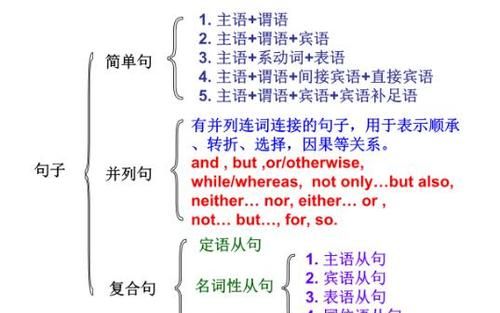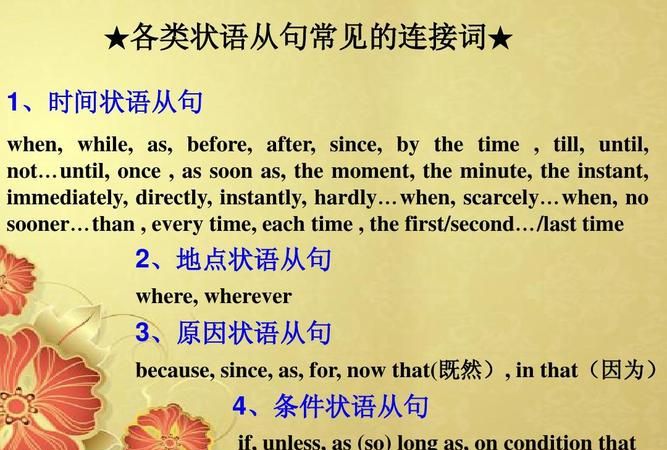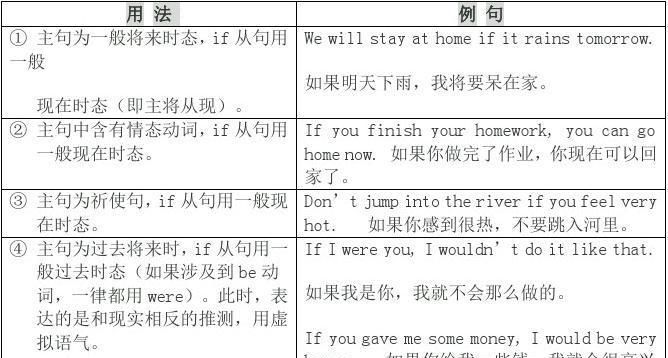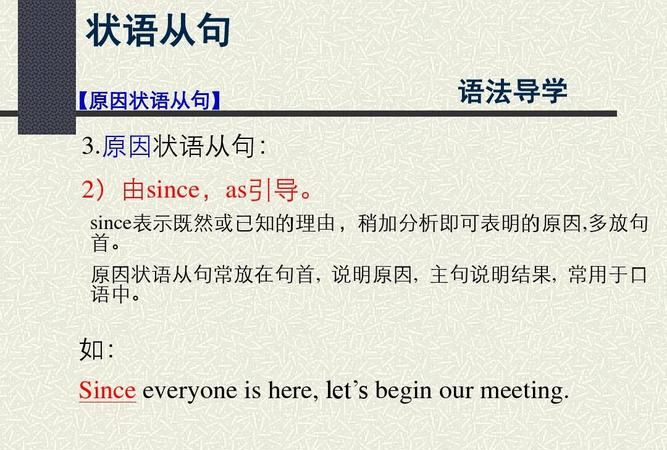本文目录
英语语法状语从句
状语(adverbial,简称adv.)是句子的一个重要修饰成分。是谓语里的另一个附加成分,从情况、时间、处所、方式、条件、对象、肯定、否定、范围和程度等方面对谓语中心词进行修饰、限制。我在这里整理了相关知识,快来学习学习吧!
英语语法:状 语 从 句
一、时间状语从句
1、when的用法
(1)when既可引导一个持续性动作,也可引导一个短暂性动作,可用于表示主句和从句动作同时发生或从句动作先于主句动作,有时还可表示从句动作后于主句,意为“当。。。时候”。
(2)when在be about to do。。。when。。。,be doing。。。when。。。,had done。。。when。。。,be on one’s way。。。when。。。,be on the point of doing。。。when。。。等结构中,作“那时突然”讲。
(3)when “既然、鉴于;尽管,虽然(位于主句之后);如果”
2、while的用法
(1)表示“当。。。时候”,引导的动作必须是延续性的。
(2)用作并列连词,表示相对关系“然而”。
(3)引导让步状语从句,相当于although,意为“虽然”,位于主句前。
(4)引导条件状语从句,相当于as/so long as,意为“只要”。
3、as 的用法
(1)表示“当。。。时候”,强调同时发生,不指先后。
(2)说明两种正在发展或变化的情况,表示“随着”,表示时间的推移。
(3)表示“一边。。。一边。。。”。
(4)强调两个动作紧接着发生。
(5)表示“虽然,尽管”。
(6)其他含义“正如,正像”,“作为”,“由于,因为”。
4、before的用法
(1)一般意为“在。。。之前”“。。。才”,“。。。就”“还没有。。。”“免得”“不知不觉”“宁可,宁愿”,“否则,要不然”。
(2)It + will be/was + 时间段+before+一般现在时/一般过去时。在肯定句中,意为“多长时间之后才”;在否定句中,意为“用不了多长时间就”。
5、until和till
(1)与肯定句连用,必须是延续性动词。
(2)与否定句连用,必须是非延续性动词,表示“直到。。。才,在。。。之前不。。。”。
注意:not until可用于强调句和倒装句
强调句:It is/was not until…that…倒装句:not until 放句首时,主句要部分倒装。
6、since的用法
(1)since后是非延续性动词,时间起点从该动作发生算起,意为“做某事多久了”;since后是延续性动词,时间起点从该动作结束算起,意为“不做某事已有多长时间”。
(2)It is/has been +时间段+since+一般过去时
7、表示“一......就......”的句型
(1)as soon as, once,immediately,directly,instantly,the moment,the minute等引导的从句都表示从句的动作一发生,主句的动作随即发生,常译作“一。。。就。。。”,这类从句中,经常用一般现在时态代替将来时态。
(2)on doing sth.或“on one’s+名词”作时间状语。
8、有些名词和副词可以起连接词的作用,引导时间状语从句。
注意:时间状语从句中不用将来时态。若要表示将来时间,可用一般现在时态表示。但when引导名词性从句时,从句中要使用将来时。
二、地点状语从句
1、地点状语从句由where,wherever引导。
注意:where与where的区别:Where表特定的地点,而wherever表示非特定的地点。
Wherever=to/at any place where
2、地点状语从句与定语从句的区别
Where引导定语从句时,从句前应有一个表示地点的名词作先行词;而状语从句前则无先行词。
三、原因状语从句
引导词:because, since,as, now that, not that…, but that…, seeing that, considering that, in that
注意:for也可以表示原因,属并列连词,但不是说明直接原因,而是对某种情况加以推断,用于表示补充说明理由。
四、目的状语从句
引导词:so, so that, in order that, that, to the end that(以便,为了),in case,for fear that,lest(以免,以防),
目的状语从句中通常有情态动词can,could,may,might,should,would等。
注意:1、in case 还可表示“万一,假如”。
2、目的状语从句可以用so as to, in order to 等不定式代替,但主句和从句的主语必须一致。
五、结果状语从句
引导词:so...that(如此。。。以至于。。。),such...that(如此。。。以至于。。。),so that(结果是),with the result that(所以,结果是)
注意:(1)so...that与such...that的区别
So+形容词such+a/an+形容词+单数名词
So+形容词+a/an+单数名词such+形容词+复数名词
So+副词such+形容词+不可数名词
So many/few+复数名词
So much/little+不可数名词
(2)so that引导的目的状语从句与so that 引导的结果状语从句
目的状语从句一般使用情态动词,结果状语从句一般不使用情态动词;
结果状语从句常常用逗号与主句分开。
(3)so...that与so...as;such...that与such...as
So...that/such...that为结果状语从句;so...as/such...as为定语从句。
六、条件状语从句
引导词:if(如果),unless(除非),if only(只要,但愿),only if(只有),in case(万一),suppose/supposing(that)
(假设),provided/providing(that)(只要,假若),on condition that(要是,在。。。条件下),so/as long as(只要),(let's/let us)say(假设)
七、方式状语从句
引导词:as(像。。。一样,正如。。。),as if/as though(好像,宛如)
注意:1、固定句型A is to B what C is to D.意为“A对B而言正如C对D一样”。
2、as if, as though引导的从句若与事实相反,用虚拟语气;若与事实相符,不用虚拟语气。
八、让步状语从句
引导词:though/although/as(虽然,尽管),even if/though(即使,尽管),whether/no matter whether...or(not)
(不管。。。是否,不管是。。。还是)wh-ever/no matter wh-(无论。。。)
注意:(1)though,although,as的区别
A、Though,although的主句中可以用yet, still, nevertheless,但不可使用but。
B、though引导的从句可以倒装,也可以不倒装;as引导的从句必须倒装;although引导的从句不能倒装。
其结构为:形容词/分词/副词/动词原形/名词(无冠词)+as/though+主语+谓语……
(2)though可用作副词,放在句末,意为“不过,但是”。Although无此用法。
(3)某些短语也引导让步的从句或短语,意为“尽管”,如:in spite of the fact that, despite the fact that, regardless of(the fact that)
九、比较状语从句
引导词:as...as(和。。。一样),not as/so...as(和。。。不一样),than(比),the more...the more...(越。。。越。。。)
十、状语从句中的省略问题
1、在状语从句中如果主语与主句的主语一致,同时从句中又含有系动词be,则通常可省去从句的主语和系动词be,留下其余部分。
2、若状语从句中主语是it, 动词是系动词be, 则通常可省去主语it及系动词be,留下其余部分。
由王宝强离婚来看看“出轨”的英语表达方式有哪些
I'd found Philippe was cheating on me and I was angry and hurt.
发觉菲利普对我不忠后,我又气愤又伤心。
I have an affair with my secretary.
我和我的秘书有暧昧关系。
I think my spouse may be unfaithful to me.
我觉得我的爱人/配偶可能不忠于我。
At the very least, my heart has been derailed.
至少,我的心已经出轨了。
We also hear the expression love-rat used quite often in popular newspapers.
“爱情老鼠”(爱情骗子,指那些经常在恋人背后出轨的人)这个表达也经常出现在那些通俗小报上。
I'm sure he's got another woman.
我确信他有了第三者。
Arthur himself has been portrayed as a weak cuckold.
亚瑟王本人被描绘成一个被人戴绿帽子的软弱之人。
After Wenzhang, Chenhe became another notorious two-timer in the entertainment world.
继文章之后,陈赫成为娱乐圈另一位臭名昭著的脚踩两只船的明星。
She was a third person in a relationship for about 11 months.

英语中让步状语从句态是什么意思
引出让步状语从句的关联词主要有:although,though(虽然),whereas(鉴于),considering(that)(就 而论),much as(虽然很);带有强烈语气的:even though,even if(即便),以及however much/badly(无论多么多/多么糟),no matter how/who等连接手段。as和though还经常采用倒装的方式引出让步状语。eg:No matter what I say ,I seen to say the wrong thing.无论我说什么,似乎都不妥.2)Despite his great wealth, he always remained a man of simple tastes.虽然他很富有,但是他生活依然很朴素.
方式状语从句:1)方式状语从句可由连词AS引导,从句一般置于句后。
EG:Tape this again as I showed you a moment ago.把这分材料按我刚才告诉你的那样在打一遍.〔as=in the way(that)〕
2)当方式状语由(in)the way(that),the way in which ,(in)the same way,(in)the same way as,according as,rather than等词语引导时,可表示比较.She is behaving(in)the same way her elder siser used to.
她的举止和她姐姐过去一模一样.
3)方式状语从句在be,act,appear,behave,ect.动词后由连词as if或as although引导时,从句表示的意思可以是”真实的”也可是”不真实的”.如是”不真实的”用过去时表示.

英语中各类状语的英文名称是什么
.时间状语;(adverbial of time)
2.地点状语;(adverbial of place)
3.原因状语;(adverbial of cause)
4.条件状语;(adverbial of condition)
5.目的状语;(adverbial of purpose)
6.让步状语;(adverbial of concession)
7.比较状语;(adverbial of comparison)
8.方式状语;(adverbial of manner)
9.结果状语。(adverbial of result)

英语语法状语从句
一. 状语从句的概念
状语:状语修饰动词、形容词、副词或全句,说明方式、因果、条件、时间、地点、让步、方向、程度、目的等。
状语在句子中的位置很灵活,常见情况为:通常在句子基本结构之后,强调时放在句首;修饰形容词或副词时,通常位于被修饰的词之前;表示时间、地点、目的的状语一般位于句子两头,强调时放在句首,地点状语一般须在时间状语之前;一些表示不确定时间(如:often)或程度(如:almost)的副词状语通常位于be动词、助动词、情态动词之后,动词之前。
二. 状语从句的类型
1. 地点状语从句
地点状语从句通常由where, wherever引导。
例如:
Where I live there are plenty of trees.
在我住的地方有很多树。
Wherever I am I will be thinking of you.
不管我在哪里,我都会想到你。
2. 方式状语从句
方式状语从句通常由as, as if, as though引导。
(1)as的用法
Will you please do the experiment as I am doing?
请按我的方法做这个实验好吗?
(2)as if, as though的用法
①引导的方式状语从句所表示的情况是事实或具有很大的可能性时,通常用陈述语气,常与look/seem/taste/smell/sound等词连用。
It looks as if it is going to rain.
看来要下雨。
②从句所表示的情况不是事实,而是主观的想象或夸大性的比喻,通常用虚拟语气。
The injured man acted as if nothing had happened to him.
这个受伤的男子行动起来似乎什么也没有发生似的。
说明:
as if/as though也可以引导一个分词短语、不定式短语。
例如:
He stared at me as if seeing me for first time.
他目不转睛地看着我,就像第一次看见我似的。
He cleared his throat as if to say something.
他清了清嗓子,像要说什么似的。
3 原因状语从句
because,as,since与for的不同用法:
相同之处:
中文都表示“因为”,均为连词。
区别:
(1) 如果表示原因的状语从句语气较强,在整个句子中占重要位置,是句子的主要部分,一般用“because”。即回答why问句的提问,应用because。
— Why did they come to China? 他们为什么要去中国?
— Because their father wanted to work in China. 因为他们的父母想到中国工作。
(2) 如果原因不重要,或为人所知,一般用as或since。它所引导的从句常常放在句首。
As you ask, I will tell you.
你既然问我,我就告诉你。
(3) for引导的句子表示原因,语气较because弱,类似一种补充说明,一般不用它来回答why提出的问题。它引导的从句不能放在句首,而且前面一般用逗号与主句分开。
We can’t go, for it’s raining.
由于天下雨,我们不能走了。
说明:
for是并列连词。
4 目的状语从句
表示目的状语从句可以由that, so that, in order that, lest, for fear that, in case等词引导。
例如:
You must speak louder so that/in order that you can be heard by all.
你必须大点声,别人就能听见了。
Better take more clothes in case the weather is cold.
最好多穿点衣服,以防天冷。
5 结果状语从句
结果状语从句常由so…that或such…that引导。so...that与such…that之间可以转换。
例如:
The boy is so young that he can’t go to school.
(= He is such a young boy that he can’t go to school.)
这男孩年龄太小,不能上学。
6 条件状语从句
连接词主要有if, unless, as/so long as, on condition that等。if引导的条件句有真实条件句和非真实条件句两种。非真实条件句已在虚拟语气中阐述。
unless = if not.
例如:
Let’s go out for a walk unless you are too tired.
(= If you are not too tied, let’s go out for a walk.)
如果不太累,我们去散散步。
典型例题
You will be late ______ you leave immediately.
A. unlessB. untilC. ifD. or
答案A。句意:除非你立即走,否则你就会迟到的。可转化为 If you don’t leave immediately, you will be late。B、D句意不对,or表转折。
7 让步状语从句
(1)though, although引导的让步状语从句,后面的从句不能有but,但是though和yet可连用。
例如:
Although it’s raining, they are still working in the field.
虽然在下雨,但他们仍在地里干活。
(2)as, though引导的让步从句必须表语或状语提前(形容词、副词、分词、实义动词提前)。
例如:
Child as though he was, he knew what was the right thing to do.
虽然他是个孩子,但是他知道该做什么,不该做什么。
(3)ever if, even though即使。
例如:
We’ll make a trip even though the weather is bad.
即使天气不好,我们也要去远足。
(4)whether…or… 不管……都。
例如:
Whether you believe it or not, it is true.
信不信由你,这确实是真的。
(5)“no matter +疑问词”或“疑问词+后缀ever”。
例如:
No matter what happened, he would not mind. (= Whatever happened, he would not mind.)
不管发生什么,他不在意。
替换:
no matter what = whatever
no matter who = whoever
no matter when = whenever
no matter where = wherever
no matter which = whichever
no matter how = however
注意 :no matter 不能引导主语从句和宾语从句。
(错)No matter what you say is of no use now.
(对)Whatever you say is of no use now.
你现在说什么也没用了。
(错)Prisoners have to eat no matter what they’re given,
(对)Prisoners have to eat whatever they’re given.
囚犯们只能给什么吃什么。
英语语法 | 状语从句【 春喜外语 】供稿!春喜外语,学英语告别复读模式,与 真人外教一对一 面对面交谈,不管帅哥还是美女都任你选择。 在线英语培训 ,只要有网络就可以轻松进入学习状态,老师、上课时间、地点你说了算。5年时间12000名学员的共同选择,欲了解更多详情,欢迎咨询在线客服!

以上就是关于方式状语从句英文表达 ,英语语法状语从句的全部内容,以及方式状语从句英文表达 的相关内容,希望能够帮到您。
